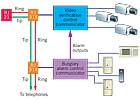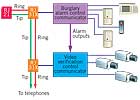Monitoring Alarms Remotely

- Video verification images can be sent via:
a. POTS lines.
b. broadband connection.
c. GSM cell phones.
d. Any of the above
e. None of the above
- Verified alarms can result in:
a. lower false alarm rates.
b. lower false alarm fees.
c. quicker police response time.
d. All of the above
e. None of the above
- Which of the following is an example of a digital dialer format?
a. Contact ID
b. SIA
c. BFSK
d. All of the above
e. None of the above
- What type of RF system can be used to monitor alarm signals?
a. Private wireless network
b. Shared wireless network
c. Digital cellular network
d. Any of the above
e. None of the above
- In order to use video to verify alarms, you must use hardwired cameras.
a. True
b. False
- What type of jack is used to connect a digital communicator to the POTS network?
a. RJ-11
b. RJ-31X
c. RJ-45
d. Any of the above
e. None of the above
- All video verification systems allow the monitoring office to look in at any time.
a. True
b. False
- Connecting a VoIP adaptor to any existing telephone jack to provide voice telephone service to the other jacks is called:
a. bus topography.
b. back-feeding.
c. star topography.
d. broadband.
e. None of the above
- A DVR with remote connection capabilities can be used to verify the cause of alarms.
a. True
b. False
- How quickly the images will load on a remote video verification system is not dependent on the transmission path employed.
a. True
b. False
- A remotely verified system can be used for:
a. burglary systems.
b. medical monitoring.
c. hold-up systems.
d. Any of the above
e. None of the above
- VoIP-based voice telephone systems can never be used for alarm transmission.
a. True
b. False
- All digital receivers can accept signals from any type of digital communicator.
a. True
b. False
- Audio can be used to verify alarm conditions.
a. True
b. False
- What is the month that the FCC has set as the “sunset” for analog cellular networks?
a. January 2008
b. February 2008
c. March 2008
d. April 2008
e. May 2008

What’s Wrong with This?
Wally ‘Larman installed a burglary system that included remote video transmission for false alarm verification using existing analog video cameras. To accomplish this, he installed a video verification communicator, connected the video outputs of the existing DVR and alarm outputs from the burglary control and shared a single POTS line for the video communicator and burglary control. He connected the devices as shown in this diagram and tested the system to make sure that the monitoring station received digital signals and video images when an alarm was generated. Everything seemed to work, but occasionally the monitoring station would receive a communication fail from the burglary control along with the alarm signals. Can you see what Wally did wrong and what he must do to correct the problem?5-Minute Tech Quiz Answers
- d
- d — All these are possible, and in some locations, it is required that alarms be verified before dispatching police.
- d
- d
- b — Although hardwired cameras are more common, wireless camera systems are available that are specifically designed for video verification. Because they are wireless, these systems have the advantage of being easy to install, especially when done as an add-on to existing burglary systems.
- b
- b — Some systems allow remote connection at any time, and others allow remote viewing only while an alarm is in progress. This can be important when installing video verification in residential applications.
- b
- a
- b — The type of communication technology employed will have a dramatic effect on the time required to transmit video images, as will the image quality and compression techniques utilized.
- d
- b — Although not all systems work properly with VoIP-based systems, equipment is available that is designed to work with VoIP.
- b — Although some digital receivers can accept signals from many different digital communicator formats, not all receivers have this capacity. You should verify that the communicators you use are compatible with your receivers and that the receivers are kept current with changes to the communication formats.
- a
- b

Answer to: What's Wrong with This?
By connecting the video communicator ahead of the burglary control, whenever the video communicator seized the telephone line, it was disconnected from the burglary control. If the line was out longer than the telephone line supervision time programmed into the burglary control, or if the burglary control needed to send a signal during this time, it would initiate a failure condition. To correct this problem, Wally can rewire the jacks so that the burglary control is ahead of the video communicator. This will ensure that the burglary control can always seize the telephone line but may inhibit or delay the transmission of video images. A better option would be to use separate communication paths.Looking for a reprint of this article?
From high-res PDFs to custom plaques, order your copy today!



